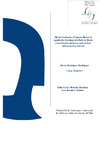Please use this identifier to cite or link to this item:
https://accedacris.ulpgc.es/handle/10553/77763
| Campo DC | Valor | idioma |
|---|---|---|
| dc.contributor.advisor | Robaina Robaina, Lidia Esther | es |
| dc.contributor.advisor | Ramírez Bolaños, Sara | es |
| dc.contributor.author | Rodríguez Rodríguez, Álvaro | es |
| dc.date.accessioned | 2021-02-17T13:04:11Z | - |
| dc.date.available | 2021-02-17T13:04:11Z | - |
| dc.date.issued | 2021 | - |
| dc.identifier.other | Gestión académica | - |
| dc.identifier.uri | https://accedacris.ulpgc.es/handle/10553/77763 | - |
| dc.description.abstract | Fish feed represent generally the most expensive production cost in aquaculture. Currently much of the research in aquaculture is focused on the search for sustainable substitutes for fish meal and oils, with interesting alternatives from new vegetable by-products. One of these is generated by the cultivation of bananas, with which the Life Baqua project is working, whose main objective is to establish a new model of circular economy for the use of this waste. The aim is to develop antioxidant additives to complement the preparation of feed for fish in aquaculture. The species chosen for the study are tilapia (Oreochromis niloticus) and sea bass (Dicentrarchus labrax), which are fed various diets composed of different levels of by-product. A histopathological study of liver was subsequently carried out to determine the effect of the different diets on the fish. | - |
| dc.language | eng | en_US |
| dc.relation | Solutions Through The New Use For A Waste Of Banana Crop To Develop Products In Aquaculture And Plastics Sector | en_US |
| dc.subject | 310502 Piscicultura | - |
| dc.title | Dietary inclusion of banana flower in aquafeeds: histological effects in tilapia (Oreochromis niloticus) and sea bass (Dicentrarchus labrax) | es |
| dc.type | info:eu-repo/semantics/bachelorThesis | en_US |
| dc.type | BachelorThesis | en_US |
| dc.contributor.departamento | Departamento de Biología | es |
| dc.contributor.facultad | Facultad de Ciencias del Mar | en_US |
| dc.investigacion | Ciencias | - |
| dc.type2 | Trabajo final de grado | en_US |
| dc.identifier.matricula | TFT-57202 | es |
| dc.identifier.ulpgc | Sí | - |
| dc.contributor.buulpgc | BU-BAS | es |
| dc.contributor.titulacion | Grado en Ciencias del Mar | es |
| item.grantfulltext | open | - |
| item.fulltext | Con texto completo | - |
| crisitem.project.principalinvestigator | Monzón Verona, Mario Domingo | - |
| crisitem.advisor.dept | GIR Grupo de Investigación en Acuicultura | - |
| crisitem.advisor.dept | IU de Investigación en Acuicultura Sostenible y Ec | - |
| crisitem.advisor.dept | Departamento de Biología | - |
| crisitem.advisor.dept | GIR Grupo de Investigación en Acuicultura | - |
| crisitem.advisor.dept | IU de Investigación en Acuicultura Sostenible y Ec | - |
| Colección: | Trabajo final de grado | |
Page view(s)
164
checked on Apr 15, 2023
Download(s)
105
checked on Apr 15, 2023
Google ScholarTM
Check
Share
Export metadata
Items in accedaCRIS are protected by copyright, with all rights reserved, unless otherwise indicated.
